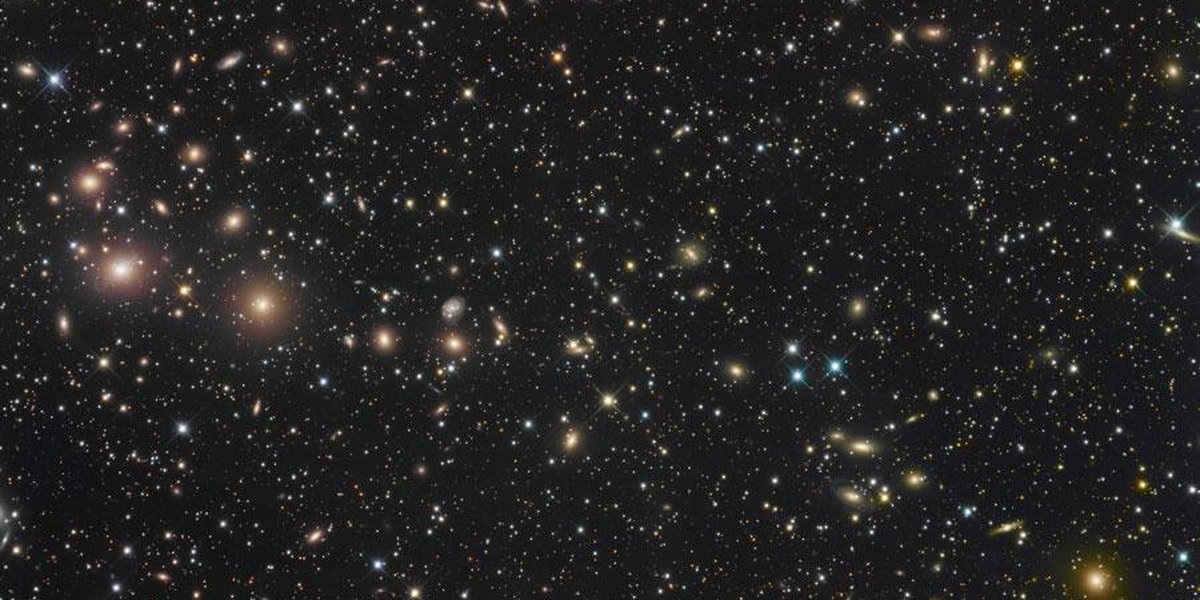TecMundo and #AstroMiniBR select the best astronomical curiosities produced by their collaborators on a weekly basis Profile on X I’d like to share a little more about the intriguing and fascinating universe of astronomy. Check out!
#1: Galactic diversity in the Abell 2744 cluster!
The morphological diversity of galaxies in clusters is one of the most fascinating aspects of studying the Cosmos. In galaxy clusters such as Abell 2744 (also known as the Pandora Cluster), we can observe a wide variety of galactic shapes, from giant ellipticals, which are usually old and form very few new stars, to spirals with well-defined arms and regions rich in star formation.
This diversity is crucial to understanding galactic evolution. because the gravitational interaction between galaxies in clusters can trigger mergers and affect the final morphology of galaxiesLocated approximately 3.5 billion light-years from Earth, this galaxy contains hundreds of galaxies, each contributing to the complexity and richness of the cluster and providing a magnificent example of morphological diversity.
The Abell 2744 cluster is notable not only for its density of galaxies, but also for being one of the best examples of a merging cluster, where many smaller clusters collide. These extreme dynamic interactions result in phenomena such as gravitational lensing, where light from more distant galaxies is distorted and magnified, allowing astronomers to observe galaxies that would otherwise be invisible.
#2: Superstorm on Saturn!
There is a unique atmospheric phenomenon at the north pole of Saturn that has intrigued scientists since its discovery: Hexagon StormFirst observed by the Voyager spacecraft in the 1980s and later studied in detail by the Cassini mission, the formation has a nearly perfect hexagonal shape, each measuring about 14,500 km in length.
This means the storm is about 30,000 km (19,000 miles) in diameter, big enough to fit four Earths side by side. The storm rotates clockwise, completing its rotation approximately every 10 hours and 39 minutes, the same amount of time it takes Saturn to rotate on its axis.
The exact reasons for the formation of this hexagonal structure are still a matter of research, but scientists believe it has to do with the dynamics of atmospheric jet streams and swirling fluids.
Unlike storms on Earth, it is driven primarily by surface heat and is influenced by the Earth’s topography. Saturn’s hexagonal storm occurs in a dense, gaseous atmosphere where there are no solid surfaces.
This event highlights the extreme differences between Earth’s climate and the climates of other planets in the solar system and highlights the complex atmospheric dynamics that govern not only Saturn but also the other gaseous planets.
#3: Super clash on Mimas!
Saturn’s moon Mimas is one of the most intriguing natural satellites in the solar system. Its appearance reminds us of the famous “Death Star” in the Star Wars saga..
This distinctive view is dominated by the massive Herschel crater, which is about 140 kilometers in diameter, almost a third of the total diameter of the moon Mimas. The crater is about 10 kilometers deep and its central peak rises about 6 kilometers above the crater floor, standing out impressively from the lunar surface.
The formation of Herschel Crater is attributed to the massive impact of a celestial body, possibly an asteroid, that occurred billions of years ago. The force of the impact was so powerful that it nearly shattered Mimas, but the moon remained intact..
Studies of Herschel and other impact craters are helping scientists better understand the geological history and dynamics of the solar system and providing clues about the frequency and magnitude of impact events over time.
Did you like the content? So, always stay up to date with more astronomical curiosities on TecMundo. Until later!
Source: Tec Mundo
I’m Blaine Morgan, an experienced journalist and writer with over 8 years of experience in the tech industry. My expertise lies in writing about technology news and trends, covering everything from cutting-edge gadgets to emerging software developments. I’ve written for several leading publications including Gadget Onus where I am an author.













